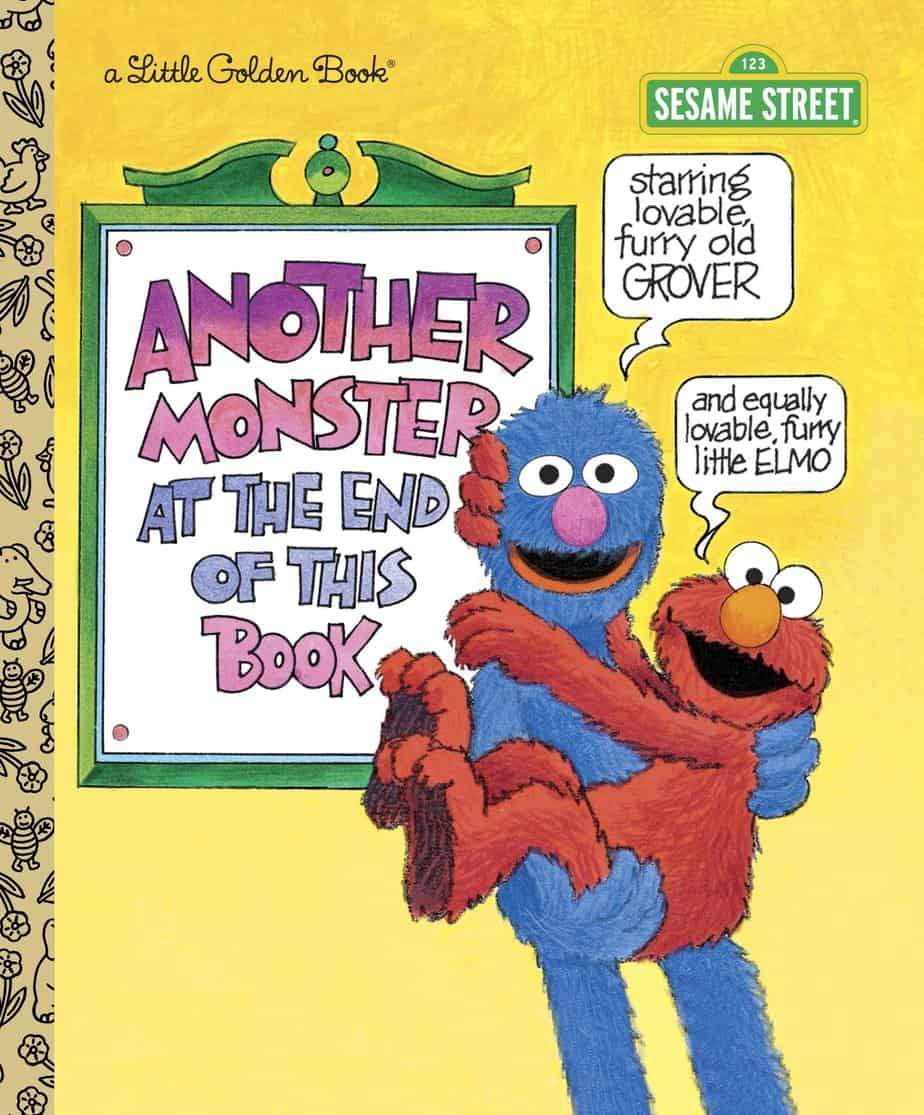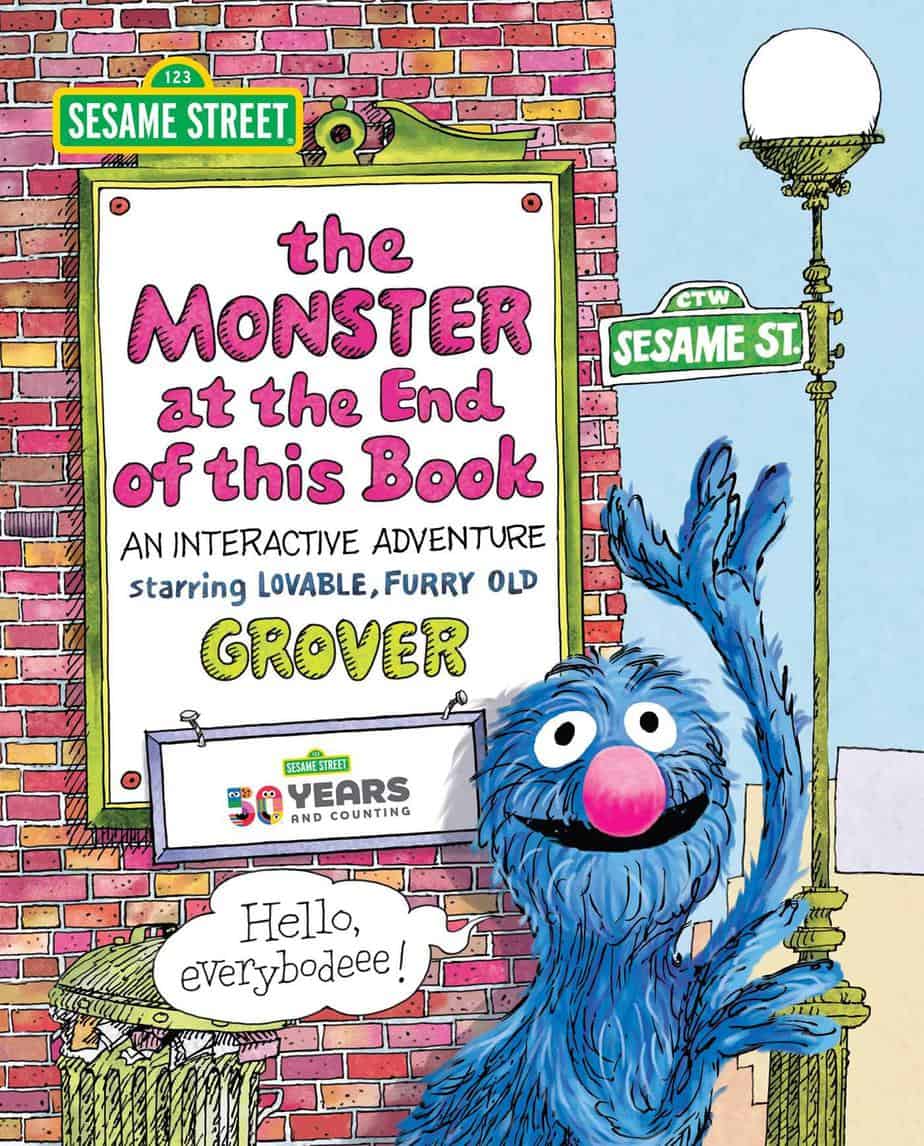The Monster At The End Of This Book by Jon Stone and Michael Smolin (1971) is possibly the most successful Little Golden Book starring Sesame Street characters. I grew up with it myself, though I can’t put my hands on it right now so I’ll be talking specifically about the app, which came out decades later, soon after the first tablet computers hit the market.
The Monster At The End Of This Book is a perfect choice for app adaptation because it is metafictional, and draws attention to itself as an object. Until reading children’s books on smart devices feels as natural as turning the paper pages of a realworld book, the novelty of interactive books is always a slightly metafictional experience, for simply being different. It is therefore a good choice to get consumers interested in reading on screen with well-established, overtly metafictional stories that always did call attention to themselves.
Below I talk about where The Monster At The End Of This Book fits inside children’s literature — its influences, its role as inspiration. I also argue that Grover is a Keynesian economist who believes the way out of a crisis is to build and build and build — creating useless jobs so at least we’re making ourselves busy, if not entirely useful…
COMEDY STORY STRUCTURE OF THE MONSTER AT THE END OF THIS BOOK
This story is one of the first of its kind — a kind of picture book that we see a lot of now: The gag. These stories tend to be 300 words or fewer, and many are made entirely of dialogue, as this one is. Mo Willems, for instance, is part of this tradition. This Book Just Ate My Dog! by Richard Byrne is also a metafictional story which turns the book object into a part of the story.
Were you scared by this book as a child? (Or scarred?)
THE SET UP
The story stars “lovable, furry old Grover”. This works so well partly because the audience is already familiar with Grover’s personality (temperament?). We know he’s naive, that he’s more like a toddler than like a monster, that he is easily distracted by and scared of many things. He’s relatable like that.
There is an opening gag to this story followed by a main gag. The opening gag is that Grover is so busy paying attention to the unusual name of illustrator Michael Smolin that he completely glosses over the text that tells him there will be a monster at the end of this book. The reader notices, but we must turn the page before Grover catches up. (This places us in audience superior position, and we believe Grover is lovably slow to catch on.)
The character who fails to notice something big is a popular gag in children’s literature, and plays into the established trope that kids notice things others do not. The character who fails to notice the obvious is the main gag of Jon Klassen’s I Want My Hat Back. This is a classic example of Misplaced Focus as a comedy technique.
For more techniques as found in children’s comedy, see this post.
Arousal Of Audience Curiosity
We are promised a monster at the end of the book.
Stirring Of Audience Imagination
Grover is super scared by this prospect and this will help the audience to imagine something truly terrifying.
Tension
Working with reverse psychology, Grover pleads with the reader not to turn the page, while the app actively encourages the reader to turn the page with a page-turn animation and accompanying SFX. The oppositional tension is between Grover and the reader.
As the reader-opponent keeps turning the page, Grover realises we won’t listen to his pleas, so he makes a plan. He sets about with rope, then with wood, hammer and nails, then with bricks. He is trying to tie/nail/brick the pages together. This is a very similar progression to what we find in The Three Little Pigs. Map house of straw, sticks and bricks onto ropes, wood and bricks. The reader is effectively Grover’s Big Bad Wolf.
The problem solved with hammer, nails and bricks is a trope I’ve seen lately in other picture books, most recently in Creepy Carrots by Aaron Reynolds and Peter Brown.
Because I’m re-reading these stories in the time of plague, I am reminded of this article by Annabel Crabb in response to the 2020 Australian budget, in which the ruling government tries to solve any problem with a combination of tax cuts (for the rich) and hands-on construction jobs (for the boys).
If the Treasury were to fill old bottles with banknotes, bury them at suitable depths in disused coal mines which are then filled up to the surface with town rubbish, and leave it to the private enterprise … to dig the notes up again … there need be no more unemployment and, with the help of the repercussions, the real income of the community … would probably become a good deal greater than it is.
John Maynard Keynes
Annabel Crabb clarifies the meaning of that analogy for us:
The point being that creating work for people, and attaching it to an income, is an end in itself for the community. Of course, he went on, if you pay people to do useful and productive stuff, it’s even better.
Go back a couple hundred years and the Irish tried to solve unemployment (and the perceived indignity that goes with) by requiring men to build mile after mile of stone fence. Number 8 wire fences are much quicker to build and do the job just as adequately. Those men could have been given money for sitting at home (looking after their families) and no one would be any the poorer.
Note that this is not a criticism of picture books making use of a funny and effective construction trope; it’s a criticism of governments whose problem solving skills haven’t progressed beyond the level of Grover.
THE PUNCHLINE
NEW INFORMATION
There is no monster at the of the book.
SUDDEN CHANGE IN AUDIENCE PERCEPTION
The monster is Grover. Grover is a monster! This is where our familiarity with Grover as a friendly muppet is challenged, and why the story works better precisely because of that familiarity; how many of us thought of Grover as a monster until this moment? I simply thought of him as a blue muppet.
RESONANCE
Picture books such as Do Not Open This Book by Andy Lee and Heath McKenzie are grandchildren of this one.
There have been some updates to this Sesame Street series, one of them to include Elmo. But is it really possible to improve on the original? Sometimes sequels feel like a voracious grab for money.

FURTHER READING
What We’ll Build is a picturebook by Oliver Jeffers. (Also about building, but all kinds of building, not just the masculine construction kind.)

